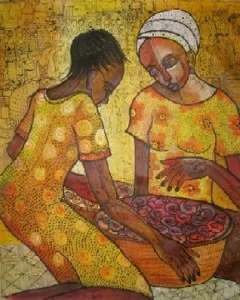
Osogbo played a seminal role in the development of contemporary art in Nigeria. But, after leaving an important imprint, it has quietly faded as a driving creative force. It is almost half a century since Williams, Beier, Wenger and the rest started the Osogbo workshops and began telling the world that this was THE contemporary art from Nigeria. But in 2008, Osogbo belongs already to the history of art, hardly to the present.
When a couple of years ago I met Babalola Lawson the first thing that came to my mind was that he had come to the world twenty years late. He is only 35, but he fits perfectly the “profile” of the Osogbo artist of the 70s and 80s. He is Yoruba, he does not have any formal education as an artist, he worked in Osogbo as an apprentice to more established names (Rufus Ogundele and Femi Johnson), he draws his imagery from Yoruba two-dimensional decorative patterns. He even worked –liked some of the first Osobgo artists- as a dancer and props manager with the Abudi Cultural Group.
But there is something else in the works of Babalola Lawson. There is a notable difference between them and the trite, dull, fossilized and commercialized productions that are still being marketed for tourists and “nouveau riche” under the name of Osogbo art. Babalola is a “natural”. He has a knack for the use of line, pattern and colour. What he lacks in conceptual depth, he makes up with his skill. He is a good artist-craftsman, unconcerned with contemporary preoccupations about meaning, identity or relevance, but producing works of more than an acceptable quality.
Babalola Lawson works within the boundaries of a tradition. If I am not mistaken, in Yoruba, the verb sa (to choose, to select) generates the word asa (tradition). In Babalola’s work his formal choices do not stray outside that tradition, that worldview, that set of conventions. He is a contemporary traditional artist, but like all good traditional artists in the Yoruba tradition, his individuality is kept alive by his sensitive departures from shared visual norms. He uses patterns, symbols and motives taken from calabash decorations, textiles, embroidery, pottery and traditional carvings and integrates them into compositions that go beyond the two-dimensionality of Yoruba tradition.
He is good at what he does and he clearly enjoys doing it. Provided you do not ask for something else, his contribution is undoubtedly valuable, as much as any honest, well finished work is important, not matter what it is. His work is not at the “cutting edge”, not even at the “blunt edge”, but I am glad I have come across Babalola. When we talk and he shows me his works I sense the satisfaction, joy and pride of somebody who is good at his trade. The fact that there is little critical discourse, that his works are quite oblivious of contemporary developments, that there are many obvious references to older Osogbo artists, does not deprive his paintings of an intrinsic quality that I appreciate.



